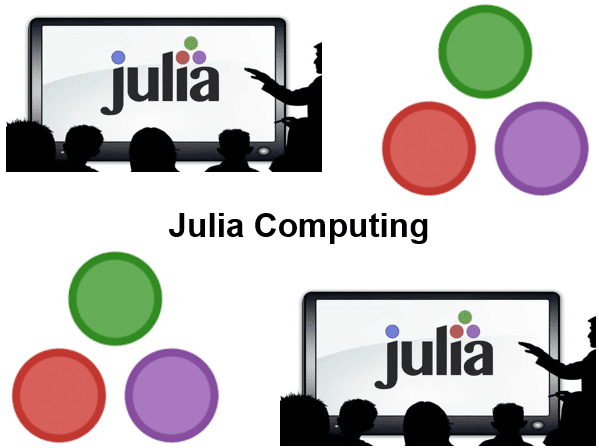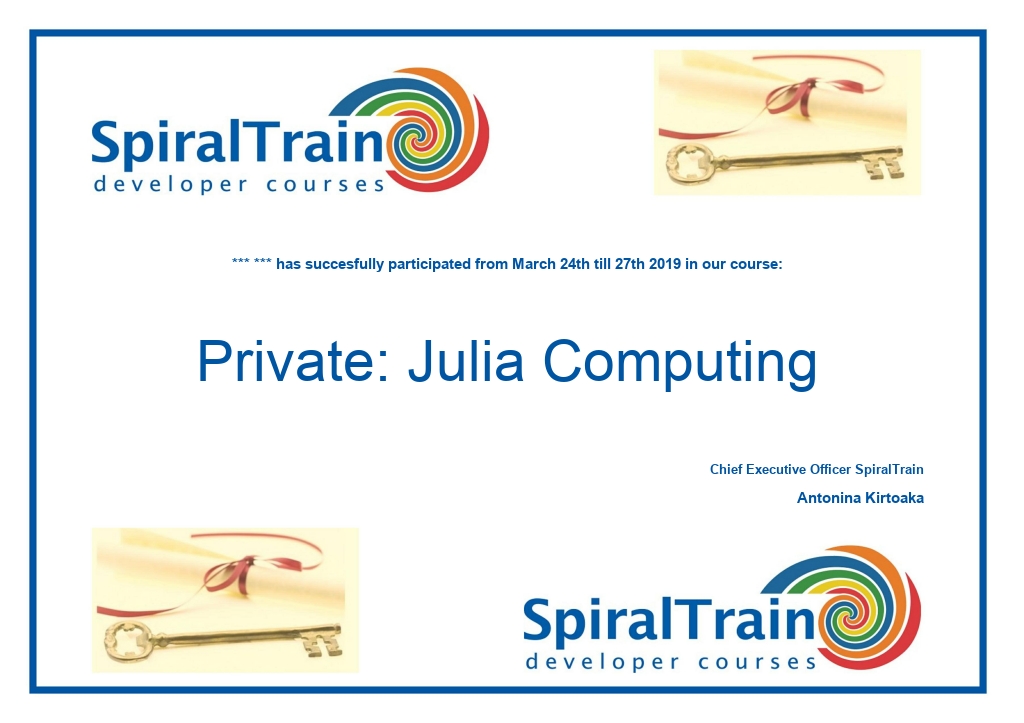-
Learning by doing
-
Trainers with practical experience
-
Classroom training
-
Detailed course material
-
Clear content description
-
Tailormade content possible
-
Training that proceeds
-
Small groups
In the course Julia Computing from SpiralTrain the participants learn to program with the dynamic programming language Julia, which is widely used in scientific calculations and gives a very good performance. Like Python and R, Julia is used for statistical calculations and data analysis, but the execution speed of Julia is much better compared to Python and R. Julia is ideally suited for big data analysis and supports complex tasks such as cloud computing and parallel execution.
The course Julia Computing starts with an overview of Julia's JIT compiler and package installation and how Julia can also be run online with JuliaBox in combination with Jupyter notebooks. Also discussed are the main features of Julia such as Parallel Processing, Multiple Dispatch and Homoiconic Macros.
Then the Julia language is treated with variables, data types, operators, classes and objects and control flow structures. Composite data structures such as arrays, sets, dictionaries and matrices and operations on them such as generator expressions and broadcasting are also discussed.
Also part of the program of the course Julia Computing are functions in Julia. Functions with multiple inputs and outputs and variable argument lists are treated and as well as anonymous functions and higher order functions such as map and reduce.
Naturally attention is also paid in the course Julia Computing to reading, processing and plotting data in Julia. Reading CSV and DLM files into DataFrames and making statistical calculations with the panda's library is covered. Data visualization with plot libraries such as Plotly and Bokeh is also treated.
Then it is time to discuss how SQL and NoSQL databases can be accessed in Julia and how REST Services can be used to read JSON and XML data.
Finally the interoperability of Julia with other languages such as Fortran and C is on the schedule of the course Julia Computing and a number of advanced applications of Julia such as Cloud computing are discussed.
The course Julia Computing is targeted at Big Data analysts and scientists who want to use Julia to analyze data and make static analyses.
Experience with programming is beneficial to good understanding but is not required.
The theory is discussed on the basis of presentations and examples. The concepts are explained with demos. There is ample time to practice the theory yourself. Juno is used as a development environment. Course times are from 9:30 am to 16:30 pm.
After successful completion of the course, participants receive an official certificate Julia Computing.

Module 1 : Julia Intro |
Module 2 : Julia Language |
Module 3 : Data Structures |
|
Intro Julian World JIT Compiler Installing Julia JuliaBox Package Installation Role in Data Science Julia Features Parallel Processing Multiple Dispatch Homoiconic Macros Interlanguage Cooperation |
Variables Data Types Number Systems Classes and Objects Object References Floating Points Flow Control Operators Strings String Interpolation Common String Functions |
Arrays and Indexing Multiple Dimensions Generator Expressions Sorting Ellipsis Operator Sets Dictionaries Keys and Values Matrices Matrix Multiplication Broadcasting |
Module 4 : Functions |
Module 5 : Working with Data |
Module 6 : Plotting |
|
Defining Functions Parameter Passing Multiple Inputs Variable Argument Lists Multiple Outputs Anonymous Functions Map and Reduce Multiple Dispatches Operators as Functions Returning Functions |
Stream and Text I/O Byte Array Streaming Reading Files Structured Data Sets CSV and DLM Files DataFrames RDataSets Statistics and Estimations Pandas Time Series |
Data Visualization Plot as Object Plots Package Default Plot Behavior Decorating Plots SubPlots Graphic Engines Plotly Bokeh Images |
Module 7 : Databases |
Module 8 : Interoperability |
Module 9 : Working with Julia |
|
Database Interface ODBC and JDBC SQLite NoSQL Datastores Key Value Systems Document Datastores RESTful interfacing HTTP Verbs JSON and XML |
Calling C and Fortran Julia API Calling API from C Metaprogramming Symbols Macros Error Handling Redirection and Pipes Parallel Operations |
Networking Frequency Analysis Stochastic Simulations Bayesian Methods Optimization Problems JuliaWeb Group Cloud Services AWS Cloud Google Cloud |
